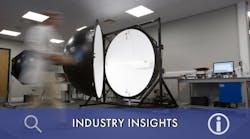LED manufacturer Nichia has announced the NCSU434B LED radiating at 280 nm and delivering radiant flux of 62 mW from a drive current of 350 mA. The ultraviolet (UV) performance in the germicidal UV-C band (100–280 nm) has been documented to deactivate the SARs-CoV-2 virus that causes COVID-19. Nichia said the LED is suitable for usage in water, near-surface, and air disinfection systems, and is commercially available immediately.
Nichia continues to focus its UV-C efforts at 280 nm, although peak germicidal efficacy has been shown to be in the 260–265-nm range. We published a feature article early this year focused on bandwidth, dose, and germicidal efficacy. But companies have generally been able to deliver UV-C LEDs at relatively longer wavelengths that have higher radiant flux and longer lifetime. The reasons for that tradeoff are buried in physical science and beyond our scope here, but you can read about the challenges of manufacturing UV-C LEDs in an article from last year.
Indeed, Nichia has stressed both high radiant flux and lifetime as critical in the evolution of its LEDs and ultimately in effective germicidal dosage. The company will not discuss details of where breakthroughs are happening. But Erik Swensen, general manager of Nichia North America, said the company will not release a product that doesn’t deliver reliability in the 10,000-hour range at L70 and at realistically high temperatures. Still, the company has pushed both radiant flux and wall plug efficiency (WPE) consistently at 280 nm.
Nichia’s previously best performing UV-C LED has been the NCSU334B LED. The 6.8×6.8-mm device was announced at the end of 2020, capable of delivering 70 mW from a drive current of 350 mW. Some at the time labeled the product a high-power device based on the old categorization criteria of LED components by drive current and wattage. The NCSU434A device was mentioned at the time as a mid-power alternative producing 17.5 mW at 100 mA.
What’s clear is that Nichia has driven performance on all vectors in the prior nine months. The NCSU434B nearly matches the NCSU334B in radiant flux in a much smaller package. Both product families have a relatively high (compared to visible-light LEDs) forward voltage in the 5.5–6V range so WPE will remain under 4%.
The smaller package will be a critical factor, according to Nichia. The company said that system designers will be able to pack the LEDs much more closely together to maximize virucidal power in smaller form factors. That compact form will enable the broad application targets mentioned earlier.
Meanwhile, Nichia has been among the more aggressive UV-C LED manufacturers in documenting the germicidal efficacy of its products. Earlier this year, the company challenged the UV-C sector to deliver complete details of UV-C LED performance with Swenson authoring a column in the March issue of our magazine.
Along with the announcement of the new LED, Nichia offered some details of experiments performed by Professor Jiro Yasuda of the National Research Center for the Control and Prevention of Infectious Diseases at the Institute of Tropical Medicine of Nagasaki University. The results are depicted nearby. A one-pass dosage of around 1 mJ/cm2 left only 4.5% of virus active. Upping that dosage to around 4 mJ/cm2 left the virus undetectable.
Admittedly, there are details missing in Nichia’s description of the tests. These tests appear to be in an air-disinfection type setting in which the new LED might be used. But details such as dimensions would be critical in determining dosage and efficacy.
LEDs Magazine chief editor MAURY WRIGHT is an electronics engineer turned technology journalist, who has focused specifically on the LED & Lighting industry for the past decade.
For up-to-the-minute LED and SSL updates, why not follow us on Twitter? You’ll find curated content and commentary, as well as information on industry events, webcasts, and surveys on our LinkedIn Company Page and our Facebook page.






